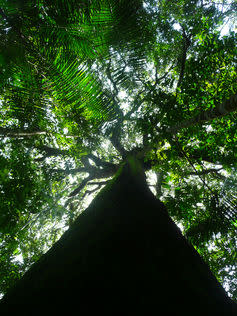The Amazon's ancient human history is written in its trees

When I started doing fieldwork in Borneo 17 years ago, most people thought of tropical forests as wildernesses, hostile to civilised human life and home only to vagrant, primitive people. Major textbooks portrayed these forests as largely unchanging over several million years.
This mindset suited common political goals, previously for imperial expansion and more lately for corporate development. Logging, ranching, mining and dam construction were seen as bringing better lives to impoverished (and inferior) hunter-gatherers and small-scale farmers.
In fact, there is growing evidence that tropical forests have been cultivated on an impressive scale for thousands of years. But there is still intense debate about the extent to which ancient human actions have altered tropical forests.

A new study of the current plantlife of the Amazon rainforest shows it has been significantly shaped by ancient people, including sophisticated groups that died out more than 500 years ago. Not only could the information about these living plants teach us about these ancient cultures, it could also help improve our approach to managing the forest today.
The researchers, led by the Naturalis Biodiversity Centre in the Netherlands, looked at 1,091 mostly one-hectare plots of land across the Amazon. They identified 85 tree species that showed signs of at least some domestication before the first Western contact, of which 20 were very common species including the cocoa tree, the Amazon grape and the Brazil nut.
They then compared how these domesticated trees, particularly the 20 common ones, were distributed against the pattern of evidence for ancient human activity. This included archaeological sites and soils showing evidence for ancient cultivation. The two sets of data didn’t cover precisely the same places. But the researchers were still able to show that plots closer to evidence for ancient human activity regularly contained many more domesticated trees.

This pattern suggests ancient people were probably managing these species within the forests by controlling the kinds of tree that grew – and quite possibly cultivating desirable trees. Some plots far from known archaeological sites also had high numbers of domesticated trees. This might be because they are close to undiscovered archaeological sites. Environmental variables and seasonality of rainfall also accounted for some of the patterning.
The link between domesticated trees and ancient human activity was particularly noticeable on the southwestern edge of the Amazon basin. This area is known to be the origin of many of the domesticated trees and crops such as manioc. And it also has the oldest evidence for human activity, with ancient cultivated soils dating from around 4,800 years ago.
Human impact

We know from accounts of the first Western voyages of discovery that tropical forests once had sophisticated societies that organised and used the vegetation on an impressive scale. And a growing body of recent research has suggested that wide-scale cultivation of a wide variety of plants in the Amazon goes back much further. One study from 2015 suggests people were domesticating plants there as long as 8,000 years ago. And in the past year, evidence has emerged of enormous agricultural settlements and cities lying abandoned below the tropical forest.
But what we haven’t known is the impact on the forest of this activity, which largely ended 500 years ago when the population collapsed as the result of epidemic diseases introduced from Europe. Doing research in the tropical forests of the world is extremely arduous, dangerous and expensive. As a result, many projects are small in scale and are therefore limited in what they can tell us. In many respects, the size, scope and rigour of this latest study provides much stronger proof of the depth of the human shaping of tropical forests than we have ever had before.
This matters, on many levels. It could help those trying to balance the desperate need to develop modern productive systems with the need to conserve forests and recognise the rights of their indigenous peoples. It could also benefit conservationists striving to find the best ways to manage these increasingly fragmented and damaged ecosystems. Not least, recognising land use as a mark of ownership and therefore land rights is vital for the indigenous peoples themselves.
Today, parts of the tropical forests of this vast region are still cultural artefacts, reflecting the activities of generations of sophisticated cultivators and forest managers. It is time for us all to see the tropical forests of the world in a new light, and to recognise the important role of their indigenous populations in shaping them –- and in their future management.
This article was originally published on The Conversation. Read the original article.

Chris O Hunt has received funding from the British Academy, AHRC and the Evans Fund for work in tropical forests.

 Yahoo News
Yahoo News 
